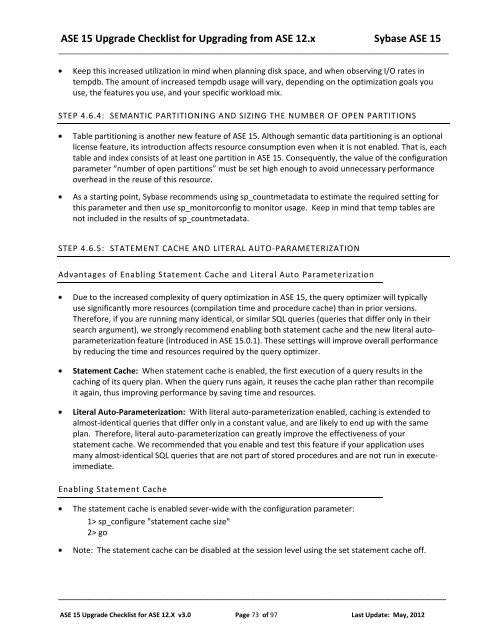Upgrading and Migrating an IQ database from older ... - Sybase
Upgrading and Migrating an IQ database from older ... - Sybase
Upgrading and Migrating an IQ database from older ... - Sybase
You also want an ePaper? Increase the reach of your titles
YUMPU automatically turns print PDFs into web optimized ePapers that Google loves.
ASE 15 Upgrade Checklist for <strong>Upgrading</strong> <strong>from</strong> ASE 12.x <strong>Sybase</strong> ASE 15<br />
_________________________________________________________________________________________________<br />
Keep this increased utilization in mind when pl<strong>an</strong>ning disk space, <strong><strong>an</strong>d</strong> when observing I/O rates in<br />
tempdb. The amount of increased tempdb usage will vary, depending on the optimization goals you<br />
use, the features you use, <strong><strong>an</strong>d</strong> your specific workload mix.<br />
STEP 4.6.4: SEMANTIC PARTITIONING AND SIZING THE NUMBER OF OPEN PARTITIONS<br />
Table partitioning is <strong>an</strong>other new feature of ASE 15. Although sem<strong>an</strong>tic data partitioning is <strong>an</strong> optional<br />
license feature, its introduction affects resource consumption even when it is not enabled. That is, each<br />
table <strong><strong>an</strong>d</strong> index consists of at least one partition in ASE 15. Consequently, the value of the configuration<br />
parameter “number of open partitions” must be set high enough to avoid unnecessary perform<strong>an</strong>ce<br />
overhead in the reuse of this resource.<br />
As a starting point, <strong>Sybase</strong> recommends using sp_countmetadata to estimate the required setting for<br />
this parameter <strong><strong>an</strong>d</strong> then use sp_monitorconfig to monitor usage. Keep in mind that temp tables are<br />
not included in the results of sp_countmetadata.<br />
STEP 4.6.5: STATEMENT CACHE AND LITERAL AUTO-PARAMETERIZATION<br />
Adv<strong>an</strong>tages of Enabling Statement Cache <strong><strong>an</strong>d</strong> Literal Auto Parameterization<br />
Due to the increased complexity of query optimization in ASE 15, the query optimizer will typically<br />
use signific<strong>an</strong>tly more resources (compilation time <strong><strong>an</strong>d</strong> procedure cache) th<strong>an</strong> in prior versions.<br />
Therefore, if you are running m<strong>an</strong>y identical, or similar SQL queries (queries that differ only in their<br />
search argument), we strongly recommend enabling both statement cache <strong><strong>an</strong>d</strong> the new literal autoparameterization<br />
feature (introduced in ASE 15.0.1). These settings will improve overall perform<strong>an</strong>ce<br />
by reducing the time <strong><strong>an</strong>d</strong> resources required by the query optimizer.<br />
Statement Cache: When statement cache is enabled, the first execution of a query results in the<br />
caching of its query pl<strong>an</strong>. When the query runs again, it reuses the cache pl<strong>an</strong> rather th<strong>an</strong> recompile<br />
it again, thus improving perform<strong>an</strong>ce by saving time <strong><strong>an</strong>d</strong> resources.<br />
Literal Auto-Parameterization: With literal auto-parameterization enabled, caching is extended to<br />
almost-identical queries that differ only in a const<strong>an</strong>t value, <strong><strong>an</strong>d</strong> are likely to end up with the same<br />
pl<strong>an</strong>. Therefore, literal auto-parameterization c<strong>an</strong> greatly improve the effectiveness of your<br />
statement cache. We recommended that you enable <strong><strong>an</strong>d</strong> test this feature if your application uses<br />
m<strong>an</strong>y almost-identical SQL queries that are not part of stored procedures <strong><strong>an</strong>d</strong> are not run in executeimmediate.<br />
Enabling Statement Cache<br />
The statement cache is enabled sever-wide with the configuration parameter:<br />
1> sp_configure "statement cache size"<br />
2> go<br />
Note: The statement cache c<strong>an</strong> be disabled at the session level using the set statement cache off.<br />
___________________________________________________________________________________________________________<br />
ASE 15 Upgrade Checklist for ASE 12.X v3.0 Page 73 of 97 Last Update: May, 2012




